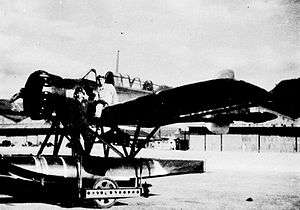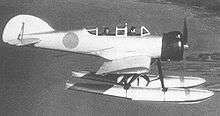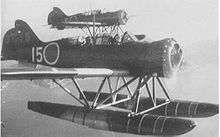Yokosuka E14Y
The Yokosuka E14Y (Allied reporting name Glen) was an Imperial Japanese Navy reconnaissance seaplane transported aboard and launched from Japanese submarine aircraft carriers such as the I-25 during World War II. The Japanese Navy designation was "Type 0 Small Reconnaissance Seaplane" (零式小型水上偵察機).
| E14Y | |
|---|---|
 | |
| Role | Submarine-based reconnaissance seaplane |
| National origin | Japan |
| Manufacturer | Yokosuka Naval Air Technical Arsenal |
| First flight | 1939 |
| Introduction | 1941 |
| Retired | 1943 |
| Primary user | Imperial Japanese Navy |
| Number built | 126 |
Design and development
Operational history

The E14Y was used for several Japanese reconnaissance missions during the Pacific War.
On 26 February 1942 the Japanese submarine I-25, under the command of Captain Meiji Tagami, was off the northern tip of King Island in Bass Strait off the coast of Victoria, Australia, when an E14Y was launched on a reconnaissance flight over the Port of Melbourne.[1] The pilot and observer/gunner were in the air for three hours, during which time they successfully flew over Port Phillip Bay and observed the ships at anchor off Melbourne before returning to land on its floats beside the submarine, where it was winched aboard and disassembled.
The E14Y is the only Japanese aircraft to overfly New Zealand during World War II (and only the second enemy aircraft after the German Friedrichshafen FF.33 'Wölfchen' during World War I). On 8 March 1942 Warrant Officer Nobuo Fujita photographed the Allied build-up in Wellington harbour in a "Glen" launched from the Japanese submarine I-25. On 13 March he flew over Auckland, before the I-25 proceeded to Australia. On the night of 24/25 May Warrant Officer Susumo Ito flew a "Glen" over Auckland from the Japanese submarine I-21. Just days later, in the same aircraft, Ito flew the reconnaissance flight preceding the sole Japanese attack on Sydney Harbour in which 21 seamen were killed when HMAS Kuttabul sank on 1 June 1942.[2]:340–6
Type A1 submarine I-9 was caught off the New Zealand coast in early 1943; however, no Japanese aircraft was observed, and any records of overflights were lost when the submarine was sunk.[3]
The E14Y also has the distinction of being the only submarine-based aircraft to drop bombs on the United States during World War II, in an incident known as The Lookout Air Raid. On 9 September 1942 , Chief Warrant Officer Nobuo Fujita, a pilot in the Japanese Imperial Navy, and his crewman, Petty Officer Shoji Okuda, surfaced in submarine I-25 off the coast of Oregon near Brookings. The seaplane had folding wings and was transported in a watertight capsule attached to the deck of the submarine. The bombs – 76 kg (168 lb) incendiaries intended to cause forest fires – caused no injuries or real damage.

Surviving aircraft
Aviation History magazine reported in the November 2008 issue[4] that divers had found airplane parts in the Akibasan Maru wreck, a Japanese cargo ship sunk in the Kwajalein Atoll on 20 January 1944, and rediscovered in 1965.[6] The parts (including wings and floats) have been finally identified (April 2008) as belonging to two E14Y1 "Glen" floatplanes, through the use of photographs from the wreck and comparisons with original technical drawings and a captured technical manual.[4]
Specifications (E14Y)

Data from Japanese Aircraft of the Pacific War[5]
General characteristics
- Crew: 2
- Length: 8.54 m (28 ft 0 in)
- Wingspan: 11 m (36 ft 1 in)
- Height: 3.8 m (12 ft 6 in)
- Wing area: 19 m2 (200 sq ft)
- Empty weight: 1,119 kg (2,467 lb)
- Gross weight: 1,450 kg (3,197 lb)
- Max takeoff weight: 1,600 kg (3,527 lb)
- Powerplant: 1 × Hitachi GK2 Tempu 12 9-cylinder air-cooled radial piston engine, 250 kW (340 hp) for take-off
- 224 kW (300 hp) at sea level
- Propellers: 2-bladed wooden propeller
Performance
- Maximum speed: 246 km/h (153 mph, 133 kn) at sea level
- Cruise speed: 167 km/h (104 mph, 90 kn) at 1,000 m (3,281 ft)
- Range: 881 km (547 mi, 476 nmi)
- Service ceiling: 5,240 m (17,190 ft)
- Time to altitude: 3,000 m (9,843 ft) in 10 minutes 11 seconds
- Wing loading: 76.3 kg/m2 (15.6 lb/sq ft)
- Power/mass: 0.1749 kW/kg (0.1064 hp/lb)
Armament
- Guns: 1× flexible, rearward-firing 7.7 mm (0.303 in) Type 92 machine gun for the observer
- Bombs: 2× 76 kg (168 lb) bombs (various)
See also
Aircraft of comparable role, configuration and era
Related lists
References
Notes
- Lester Hunt, “Bass Strait lighthouses and a Japanese reconnaissance flight in 1942,” History News, Issue 341, April 2019, p.4-5
- Dunhunty, Philip (2009). Never a Dull Moment. Philip Dulhunty.
- Chris Rudge (2003), Air to Air the story behind the air combat claims of the RNZAF, Adventure Air
- "Surviving Glens Discovered at Kwajalein." Aviation History, November 2008.
- Francillon 1979, p. 453.
- Farnham, dan. "The E14Y1 'Glen' wrecks of the Akibansan Maru". www.j-aircraft.com. Retrieved 15 April 2015.
Bibliography
- Francillon, Ph.D., René J. Japanese Aircraft of the Pacific War. London: Putnam & Company Ltd., 1979. ISBN 0-370-30251-6.
- Green, William. War Planes of the Second World War, Volume Six: Floatplanes. London: Macdonald & Co (Publishers) Ltd., 1962.
- Ishiguro, Ryusuke and Tadeusz Januszewski. Kugisho E14Y "Glen". Sandomierz, Poland/Redbourn, UK: MMP Books, 2010. ISBN 978-8389450616.
- Jackson, Robert. The Encyclopedia of Military Aircraft. Bath, UK: Parragon Books Ltd., 2006. ISBN 1-4054-2465-6.
- Januszewski, Tadeusz. Japanese Submarine Aircraft. Sandomierz, Poland/Redbourn, UK: Mushroom Model Publications, 2002. ISBN 83-916327-2-5.
- Thorpe, Donald W. Japanese Naval Air Force Camouflage and Markings World War II. Fallbrook, California: Aero Publishers Inc., 1977. ISBN 0-8168-6587-6.
External links
| Wikimedia Commons has media related to Yokosuka E14Y. |
- Yokosuka E14Y Allied Code Name: "Glen" – www.combinedfleet.com
- Yokosuka E14Y (Glen) including the fire-bombing, August 1942 – Pacific Wrecks